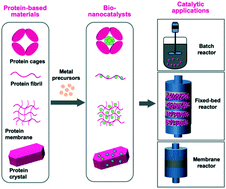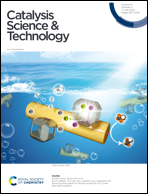Fabrication of nanohybrids assisted by protein-based materials for catalytic applications†
Abstract
The application of protein units and architectures as supports in the synthesis of metal and metal oxide nanoparticles (NPs) is a relatively new emerging issue. While avoiding toxic stabilizers and solvents, this new synthesis route mostly fulfils the long-desired prospect of designing and synthesizing size- and morphology-controlled nanocatalysts with long-term stability towards maintaining their catalytic activity during reactions and facilitating their separation and recycling. Biotemplates of protein units and architectures with different dimensions, such as protein cages, bacteriophages, protein fibers, protein membranes, and protein crystals, have been widely adopted for the controllable synthesis and immobilization of metal and metal oxide NPs, owing to their abundant functional surface groups for NP anchoring and well-defined structures for accommodating NPs. Various bioinorganic nanohybrids have been constructed and applied in electrocatalysis for fuel cells, photocatalysis for clean energy and pollutant remediation, hydrogenation and oxidation reactions, catalytic syntheses of organic chemicals, etc. This review is meant to present several pivotal aspects of nanocatalysts, their protein-assisted synthesis and their catalytic applications, providing a description of common protein biotemplates, synthesized NPs and applied catalytic reactions.



 Please wait while we load your content...
Please wait while we load your content...